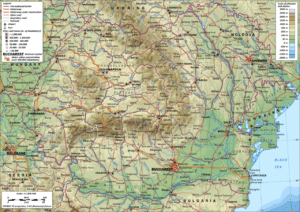
In November 2014, Sibiu former FDGR/DFDR mayor Klaus Iohannis was elected president, unexpectedly defeating former Prime Minister Victor Ponta, who had been previously leading in the opinion polls. This surprise victory was attributed by many analysts to the implication of the Romanian diaspora in the voting process, with almost 50% casting ballots for Klaus Iohannis in the first round, compared to only 16% for Ponta. In 2019, Iohannis was re-elected president in a landslide victory over former Prime Minister Viorica Dăncilă.
After the end of the Cold War, Romania developed closer ties with Western Europe and the United States, eventually joining NATO in 2004, and hosting the 2008 summit in Bucharest.

The country applied in June 1993 for membership in the European Union and became an Associated State of the EU in 1995, an Acceding Country in 2004, and a full member on 1 January 2007.
During the 2000s, Romania enjoyed one of the highest economic growth rates in Europe and has been referred at times as “the Tiger of Eastern Europe”. This has been accompanied by a significant improvement in living standards as the country successfully reduced domestic poverty and established a functional democratic state. However, Romania’s development suffered a major setback during the late-2000s’ recession leading to a large gross domestic product contraction and a budget deficit in 2009. This led to Romania borrowing from the International Monetary Fund. Worsening economic conditions led to unrest and triggered a political crisis in 2012.
Romania still faces problems related to infrastructure, medical services, education, and corruption. Near the end of 2013, The Economist reported Romania again enjoying “booming” economic growth at 4.1% that year, with wages rising fast and a lower unemployment than in Britain. Economic growth accelerated in the midst of government liberalizations in opening up new sectors to competition and investment—most notably, energy and telecoms. In 2016 the Human Development Index ranked Romania as a nation of “Very High Human Development”.

Following the experience of economic instability throughout the 1990s, and the implementation of a free travel agreement with the EU, a great number of Romanians emigrated to Western Europe and North America, with particularly large communities in Italy, Germany and Spain. In 2016, the Romanian diaspora was estimated to be over 3.6 million people, the fifth-highest emigrant population in the world.
Geography:
Romania is the largest country in Southeastern Europe and the twelfth-largest in Europe, having an area of 238,397 square kilometers (92,046 sq mi). The terrain is distributed roughly equally between mountains, hills, and plains.

The Carpathian Mountains dominate the center of Romania, with 14 mountain ranges reaching above 2,000 m or 6,600 ft—the highest is Moldoveanu Peak at 2,544 m or 8,346 ft. They are surrounded by the Moldavian and Transylvanian plateaus, the Carpathian Basin and the Wallachian plains.
Economy:
In 2019, Romania has a GDP (PPP) of around $547 billion and a GDP per capita (PPP) of $28,189. According to the World Bank, Romania is a high-income economy. According to Eurostat, Romania’s GDP per capita (PPS) was 70% of the EU average (100%) in 2019, an increase from 44% in 2007 (the year of Romania’s accession to the EU), making Romania one of the fastest growing economies in the EU.
